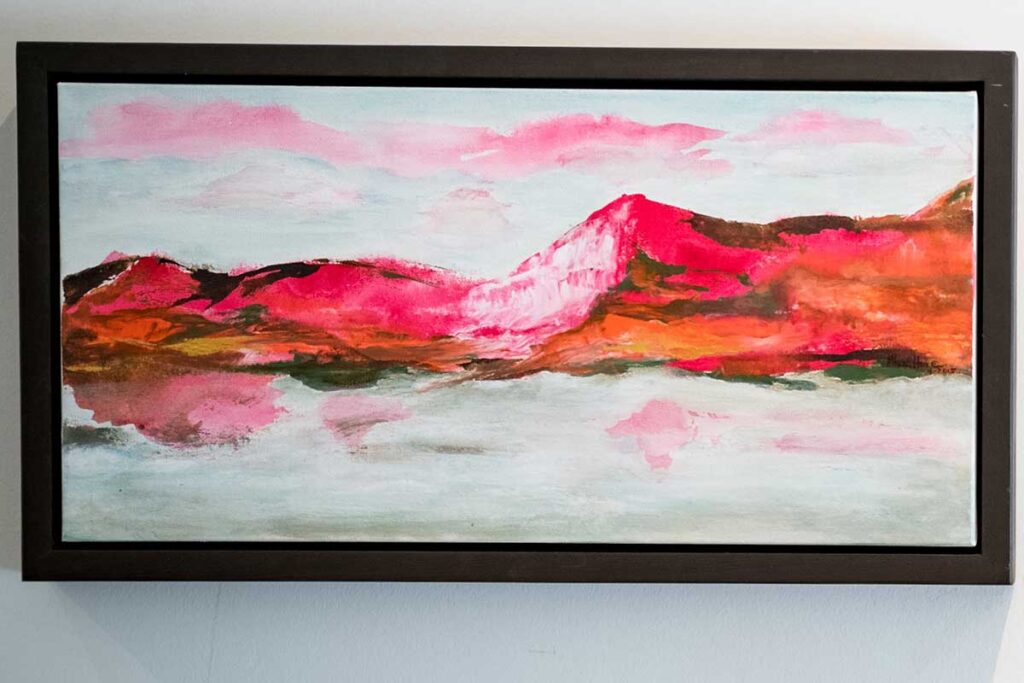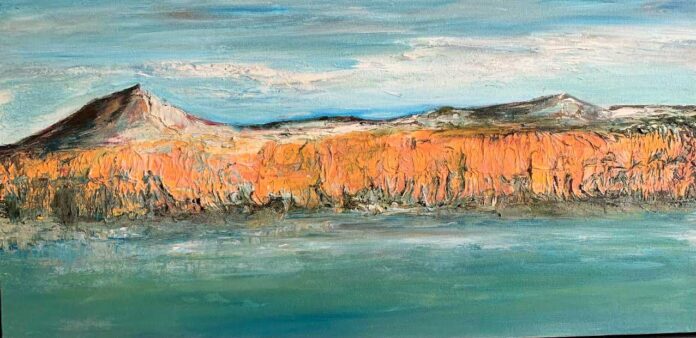Stepping inside the Bradbury-Sullivan LGBT Community Center’s Fine Art Galleries, located at 21 North 7th Street in Allentown, feels a bit like embarking on a good hike.
That’s because the current exhibit, “Landscapes,” takes viewers on a satisfying emotional trek over rugged but beautiful terrain.
“Landscapes,” which opened on April 20, features 16 acrylic paintings by Ana M. Hamilton, an Allentown-area artist and member of the LGBTQ community. Most of the paintings depict a body of water, a rocky outcrop or mountain, and the sky above.
Despite the similar imagery, Hamilton’s paintings vary in tone. Some, like “Love Mars,” have soft gradations between the elements. Others, like “Peaceful Pain,” show more detail, which lends them an edgier feel. Overall, “Landscapes” is more about emotions than an accurate representation of nature.
Hamilton, whose father was a portrait photographer in Cuba, has been making art since childhood, but in the past 10 years she’s been especially productive and focused. Today, she’s a member of the Expressions-Studio in Allentown and has shown her work in New York City, Los Angeles, and Barcelona, among other places.
Hamilton certainly appreciates the positive reception her work has gotten, but that’s not what motivates her. “My biggest satisfaction is to be able to do it,” she said.
“Landscapes” is a return of sorts for Hamilton. She’s done two earlier exhibits at the Bradbury-Sullivan Center: “I’m Here / Tiger Lillies” in 2016, and “Goddesses,” a 2017 exhibit with fellow artist Andi Grunberg.
For the current show, Hamilton selected works from an ongoing series of natural scenes that she’s been painting. Viewers will recognize natural features like shorelines and mountains, but there are no details tying the images to actual locations. That’s a deliberate strategy on her part.
“I am not the kind of landscape artist that goes and sits in front of a tree or a mountain or a river and tries to paint it,” Hamilton said. “Most of it is memories and energy that goes into the canvas.”

Rather than painting en plein air or working from a photograph, Hamilton relies on her imagination. That choice releases her from the expectation to be realistic and opens up more artistic possibilities.
“To me, it’s all about the freedom of expression,” Hamilton said. “Whether a mountain is green or red, purple or yellow, or whatever, it is irrelevant that it is real or not. It’s ‘how does it make you feel’ when you put that color there.”
One example of Hamilton’s playful use of color is “At Rest,” which depicts a mountain range in the distance. The image is suffused with a vibrant pink. It colors the mountains, dapples the clouds, and is even visible in the indistinct region towards the bottom of the painting. It could be a sunset, or it could be a blush, or something else that resonates with the viewer.
Some of the landscapes include details that draw the eyes. A good example is “Bluffs,” which shows a rocky cliff alongside a large body of water. From a distance, the detail seems to indicate the cliff’s edge and its rocky surface. Up close, it’s indeterminate but vaguely harsh. It’s also slightly tactile.
Hamilton explained that she achieves this effect by applying extremely thin bits of paper to the canvas before beginning to paint. It’s a technique she learned from her cousin, a fellow artist in Miami. “Sometimes, if I paint, I don’t want to dwell so much on the details and the particular parts of it,” she said. “But this allows me to do it in a way where you will see a little more detail.”
One detail that seems to be missing in Hamilton’s landscapes is people. There are no recognizable persons on these shorelines or mountain ranges, which can be disorienting.
Look more closely, however, and some of the paintings reveal what appear to be large female figures hidden within the landscape. The slope of a mountain, say, or the decline in a valley might suggest the curves of a woman’s body. That figure may be somewhat indistinct, as in “As You Left Me,” but it’s still suggestive.
It’s not deliberate, according to Hamilton. “I think sometimes, unconsciously, the figures appear,” she said. “And then I just follow that idea. Other times, it’s a surprise.”
Hamilton went on to say that she views nature as feminine. Undoubtedly, that influences her landscapes. Still, she prefers to let viewers make up their own minds.
“I pretty much leave that to the person to say, ‘Is that a woman, or maybe it’s just my imagination?’” she said.
For Hamilton, beauty really is in the eye of the beholder.“Landscapes” is on display through June 30.
The gallery is open Tuesdays through Fridays from 11 a.m. to 6 p.m. For more information, visit www.bradburysullivancenter.org/galleries.

